Multi-Temporal Normalized Difference Vegetation Index Based on High Spatial Resolution Satellite Images Reveals Insight-Driven Edaphic Management Zones
Abstract
:1. Introduction
2. Materials and Methods
2.1. Study Area
2.2. Remote Sensing Data
2.3. Generating MZs
2.4. Statistical Analysis for Comparing MZs
3. Results
4. Discussion
5. Conclusions
Author Contributions
Funding
Data Availability Statement
Acknowledgments
Conflicts of Interest
Appendix A
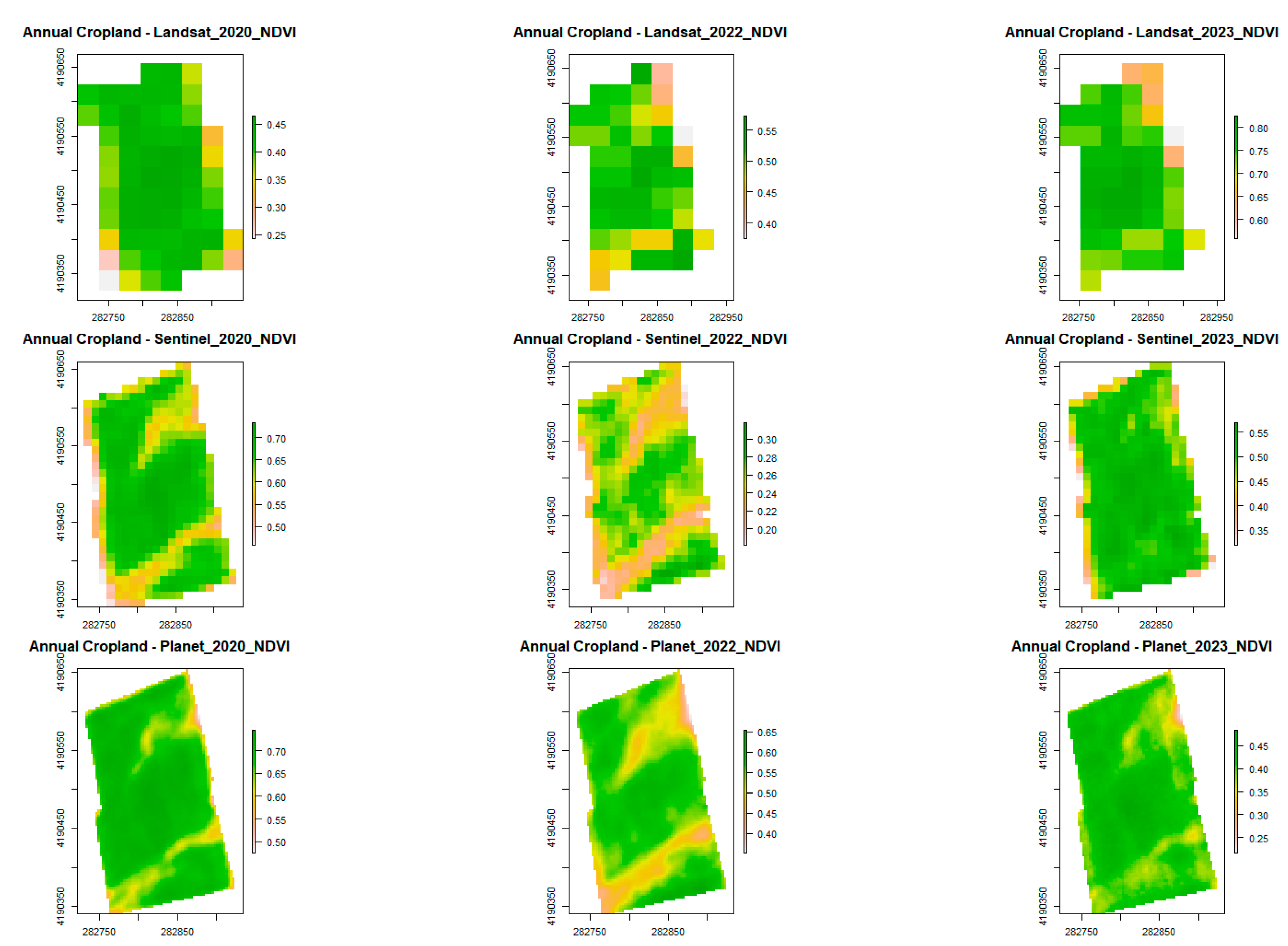
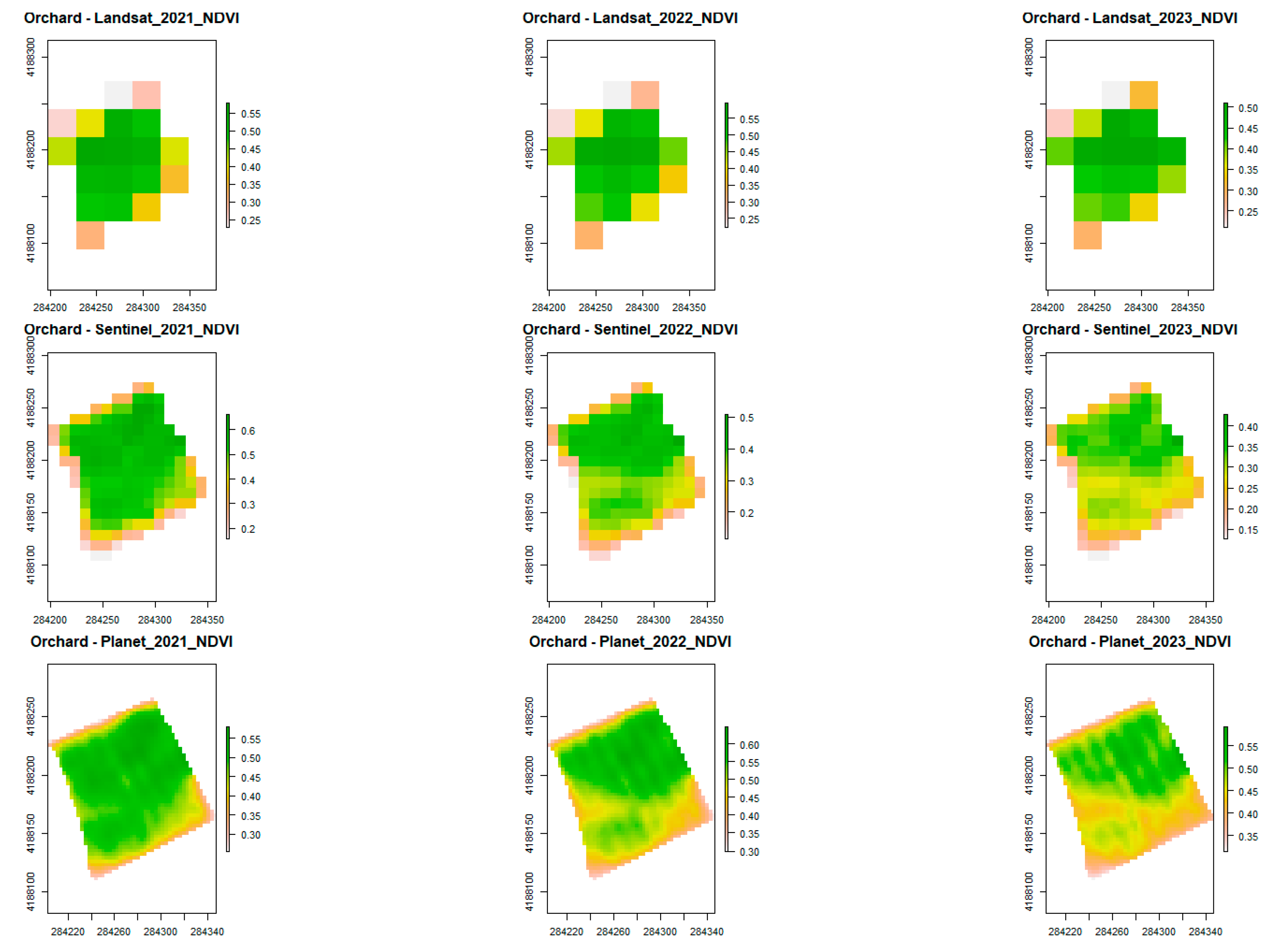
References
- Ferhatoglu, C. Delineating Precision Agriculture Management Zones Using Satellite Imagery, Web Soil Survey, and Machine Learning. Master’s Thesis, North Carolina State University, Raleigh, NC, USA, 2019. [Google Scholar]
- Corti, M.; Gallina, P.M.; Cavalli, D.; Ortuani, B.; Cabassi, G.; Cola, G.; Vigoni, A.; Degano, L.; Bregaglio, S. Evaluation of In-Season Management Zones from High-Resolution Soil and Plant Sensors. Agronomy 2020, 10, 1124. [Google Scholar] [CrossRef]
- Georgi, C.; Spengler, D.; Itzerott, S.; Kleinschmit, B. Automatic Delineation Algorithm for Site-Specific Management Zones Based on Satellite Remote Sensing Data. Precis. Agric. 2018, 19, 684–707. [Google Scholar] [CrossRef]
- Guo, Y.; Shi, Z.; Li, H.Y.; Triantafilis, J. Application of Digital Soil Mapping Methods for Identifying Salinity Management Classes Based on a Study on Coastal Central China. Soil Use Manag. 2013, 29, 445–456. [Google Scholar] [CrossRef]
- Cammarano, D.; Zha, H.; Wilson, L.; Li, Y.; Batchelor, W.D.; Miao, Y. A Remote Sensing-Based Approach to Management Zone Delineation in Small Scale Farming Systems. Agronomy 2020, 10, 1767. [Google Scholar] [CrossRef]
- Breunig, F.M.; Galvão, L.S.; Dalagnol, R.; Dauve, C.E.; Parraga, A.; Santi, A.L.; Della Flora, D.P.; Chen, S. Delineation of Management Zones in Agricultural Fields Using Cover–Crop Biomass Estimates from PlanetScope Data. Int. J. Appl. Earth Obs. Geoinf. 2020, 85, 102004. [Google Scholar] [CrossRef]
- Catania, P.; Ferro, M.V.; Orlando, S.; Vallone, M. Grapevine and Cover Crop Spectral Response to Evaluate Vineyard Spatio-Temporal Variability. Sci. Hortic. 2025, 339, 113844. [Google Scholar] [CrossRef]
- Fridgen, J.J.; Kitchen, N.R.; Sudduth, K.A.; Drummond, S.T.; Wiebold, W.J.; Fraisse, C.W. Management Zone Analyst (MZA). Agron. J. 2004, 96, 100–108. [Google Scholar] [CrossRef]
- Sozzi, M.; Kayad, A.; Giora, D.; Sartori, L.; Marinello, F. Cost-Effectiveness and Performance of Optical Satellites Constellation for Precision Agriculture. In Precision Agriculture 2019—Papers Presented at the 12th European Conference on Precision Agriculture, ECPA 2019; Wageningen Academic: Leiden, The Netherlands, 2019; pp. 501–507. [Google Scholar] [CrossRef]
- OneSoil. Available online: https://onesoil.ai/en (accessed on 10 November 2024).
- Doktar. Available online: https://www.doktar.com/tr/orbit-uydudan-takip (accessed on 10 November 2024).
- KORBİS. Available online: https://tarimkredi.org.tr/faaliyetler/korbis/ (accessed on 10 November 2024).
- Tarla.Io. Available online: https://www.tarla.io/tr-TR (accessed on 10 November 2024).
- Mendes, J.; Pinho, T.M.; Dos Santos, F.N.; Sousa, J.J.; Peres, E.; Boaventura-Cunha, J.; Cunha, M.; Morais, R. Smartphone Applications Targeting Precision Agriculture Practices—A Systematic Review. Agronomy 2020, 10, 855. [Google Scholar] [CrossRef]
- Filippi, P.; Whelan, B.M.; Bishop, T.F.A. Proximal and Remote Sensing—What Makes the Best Farm Digital Soil Maps? Soil Res. 2024, 62, SR23112. [Google Scholar] [CrossRef]
- Damian, J.M.; Pias, O.H.d.C.; Cherubin, M.R.; Fonseca, A.Z.d.; Fornari, E.Z.; Santi, A.L. Applying the NDVI from Satellite Images in Delimiting Management Zones for Annual Crops. Sci. Agric. 2020, 77, e20180055. [Google Scholar] [CrossRef]
- Termin, D.; Linker, R.; Baram, S.; Raveh, E.; Ohana-Levi, N.; Paz-Kagan, T. Dynamic Delineation of Management Zones for Site-Specific Nitrogen Fertilization in a Citrus Orchard. Precis. Agric. 2023, 24, 1570–1592. [Google Scholar] [CrossRef]
- Mohr, J.; Tewes, A.; Ahrends, H.; Gaiser, T. Assessing the Within-Field Heterogeneity Using Rapid-Eye NDVI Time Series Data. Agriculture 2023, 13, 1029. [Google Scholar] [CrossRef]
- Song, X.; Wang, J.; Huang, W.; Liu, L.; Yan, G.; Pu, R. The Delineation of Agricultural Management Zones with High Resolution Remotely Sensed Data. Precis. Agric. 2009, 10, 471–487. [Google Scholar] [CrossRef]
- Fletcher, R.S.; Escobar, D.E.; Skaria, M. Evaluating Airborne Normalized Difference Vegetation Index Imagery for Citrus Orchard Surveys. Horttechnology 2004, 14, 91–94. [Google Scholar] [CrossRef]
- Reyes, F.; Casa, R.; Tolomio, M.; Dalponte, M.; Mzid, N. Soil Properties Zoning of Agricultural Fields Based on a Climate-Driven Spatial Clustering of Remote Sensing Time Series Data. Eur. J. Agron. 2023, 150, 126930. [Google Scholar] [CrossRef]
- Rodrigues, H.; Ceddia, M.B.; Vasques, G.M.; Mulder, V.L.; Heuvelink, G.B.M.; Oliveira, R.P.; Brandão, Z.N.; Morais, J.P.S.; Neves, M.L.; Tavares, S.R.L. Remote Sensing and Kriging with External Drift to Improve Sparse Proximal Soil Sensing Data and Define Management Zones in Precision Agriculture. AgriEngineering 2023, 5, 2326–2348. [Google Scholar] [CrossRef]
- Breunig, F.M.; Galvão, L.S.; Dalagnol, R.; Santi, A.L.; Della Flora, D.P.; Chen, S. Assessing the Effect of Spatial Resolution on the Delineation of Management Zones for Smallholder Farming in Southern Brazil. Remote Sens. Appl. 2020, 19, 100325. [Google Scholar] [CrossRef]
- Chatzidavid, D.; Kokinou, E.; Gerarchakis, N.; Kontogiorgakis, I.; Bucaioni, A.; Bogdanovic, M. Delineation Protocol of Agricultural Management Zones (Olive Trees and Alfalfa) at Field Scale (Crete, Greece). Remote Sens. 2024, 16, 4486. [Google Scholar] [CrossRef]
- Sapkota, A.; Verdi, A.; Scudiero, E.; Montazar, A. Assessing the Effectiveness of Satellite and UAV-Based Remote Sensing for Delineating Alfalfa Management Zones under Heterogeneous Rootzone Soil Salinity. Smart Agric. Technol. 2024, 9, 100583. [Google Scholar] [CrossRef]
- Kaya, F.; Schillaci, C.; Keshavarzi, A.; Basayigit, L. Predictive Mapping of Electrical Conductivity and Assessment of Soil Salinity in a Western Türkiye Alluvial Plain. Land 2022, 11, 2148. [Google Scholar] [CrossRef]
- Gorelick, N.; Hancher, M.; Dixon, M.; Ilyushchenko, S.; Thau, D.; Moore, R. Google Earth Engine: Planetary-Scale Geospatial Analysis for Everyone. Remote Sens. Environ. 2017, 202, 18–27. [Google Scholar] [CrossRef]
- Planet Team Planet Application Program Interface. Available online: https://www.planet.com/explorer/ (accessed on 8 September 2022).
- Planet. Planet Imagery Product Specifications. Available online: https://assets.planet.com/docs/Planet_Combined_Imagery_Product_Specs_letter_screen.pdf (accessed on 10 November 2024).
- Landsat 8 Data Users Handbook|U.S. Geological Survey. Available online: https://www.usgs.gov/media/files/landsat-8-data-users-handbook (accessed on 10 November 2024).
- Sentinel-2 User Handbook. Issue 1 Revision 1. 2013. Available online: https://sentinel.esa.int/documents/247904/685211/Sentinel-2_User_Handbook (accessed on 10 November 2024).
- Ashley, M.D.; Rea, J. Seasonal Vegetation Differences from ERTS Imagery. Photogramm. Eng. Remote Sens. 1975, 41, 713–719. [Google Scholar]
- ESRI. ArcGIS Desktop 10.8.2 Documentation. Environmental Systems Research Institute. Available online: https://desktop.arcgis.com (accessed on 10 November 2024).
- Sentinel-2 User Handbook; 1.2.; European Space Agency (ESA): Paris, France, 2015.
- Pereira, G.W.; Valente, D.S.M.; de Queiroz, D.M.; Coelho, A.L.d.F.; Costa, M.M.; Grift, T. Smart-Map: An Open-Source QGIS Plugin for Digital Mapping Using Machine Learning Techniques and Ordinary Kriging. Agronomy 2022, 12, 1350. [Google Scholar] [CrossRef]
- QGIS Development Team. QGIS Geographic Information System. 2023. QGIS GeographicInformation System. Open-Source Geospatial Foundation Project. Available online: http://qgis.osgeo.org (accessed on 10 November 2024).
- Odeh, I.O.A.; McBratney, A.B.; Chittleborough, D.J. Soil Pattern Recognition with Fuzzy-c-Means: Application to Classification and Soil-Landform Interrelationships. Soil Sci. Soc. Am. J. 1992, 56, 505–516. [Google Scholar] [CrossRef]
- Bezdek, J.C. Pattern Recognition with Fuzzy Objective Function Algorithms, 1st ed.; Bezdek, J.C., Ed.; Springer: New York, NY, USA, 1981; ISBN 978-1-4757-0452-5. [Google Scholar]
- Smart Map (Version 1.4.2) [QGIS plugin]. QGIS Python Plugins Repository. Available online: https://plugins.qgis.org/plugins/Smart_Map/ (accessed on 10 November 2024).
- Sandonís-Pozo, L.; Llorens, J.; Escolà, A.; Arnó, J.; Pascual, M.; Martínez-Casasnovas, J.A. Satellite Multispectral Indices to Estimate Canopy Parameters and Within-Field Management Zones in Super-Intensive Almond Orchards. Precis. Agric. 2022, 23, 2040–2062. [Google Scholar] [CrossRef]
- Segarra, J.; Araus, J.L.; Kefauver, S.C. Farming and Earth Observation: Sentinel-2 Data to Estimate within-Field Wheat Grain Yield. Int. J. Appl. Earth Obs. Geoinf. 2022, 107, 102697. [Google Scholar] [CrossRef]
- Singh, K.; Fuentes, I.; Al-Shammari, D.; Fidelis, C.; Butubu, J.; Yinil, D.; Sharififar, A.; Minasny, B.; Guest, D.I.; Field, D.J. E-Agriculture Planning Tool for Supporting Smallholder Cocoa Intensification Using Remotely Sensed Data. Remote Sens. 2023, 15, 3492. [Google Scholar] [CrossRef]
- Fassa, V.; Pricca, N.; Cabassi, G.; Bechini, L.; Corti, M. Site-Specific Nitrogen Recommendations’ Empirical Algorithm for Maize Crop Based on the Fusion of Soil and Vegetation Maps. Comput. Electron. Agric. 2022, 203, 107479. [Google Scholar] [CrossRef]
- Abdi, H.; Williams, L.J. Tukey’s Honestly Significant Difference (HSD). In Encyclopedia of Research Design; Salkind, N.J., Ed.; SAGE Publications, Inc.: Thousand Oaks, CA, USA, 2010; ISBN 9781412961288. [Google Scholar]
- Oldoni, H.; Amaral, L.R.; Figueiredo, G.K.D.A.; Magalhães, P.S.G. 75. Impact of Changing Attributes on the Management Zones for Integrated Crop-Livestock System. In Proceedings of the Precision Agriculture ’23; Wageningen Academic Publishers: Leiden, The Netherlands, 2023; pp. 595–601. [Google Scholar]
- Torres-Quezada, E.; Fuentes-Peñailillo, F.; Gutter, K.; Rondón, F.; Marmolejos, J.M.; Maurer, W.; Bisono, A. Remote Sensing and Soil Moisture Sensors for Irrigation Management in Avocado Orchards: A Practical Approach for Water Stress Assessment in Remote Agricultural Areas. Remote Sens. 2025, 17, 708. [Google Scholar] [CrossRef]
- General Directorate of Rural Services (GDRS). Isparta İli Arazi Varlığı (Land Resources of Isparta Province); General Directorate of Rural Services (GDRS): Ankara, Türkiye, 1994; pp. 1–97.
- Snapp, S. Embracing Variability in Soils on Smallholder Farms: New Tools and Better Science. Agric. Syst. 2022, 195, 103310. [Google Scholar] [CrossRef]
- Herrick, J.E.; Maynard, J.M.; Bestelmeyer, B.T.; Carey, C.J.; Salley, S.W.; Shepherd, K.; Stewart, Z.P.; Wills, S.A.; Ziadat, F.M. Practical Guidance for Deciding Whether to Account for Soil Variability When Managing for Land Health, Agricultural Production, and Climate Resilience. J. Soil Water Conserv. 2023, 78, 125A–133A. [Google Scholar] [CrossRef]
- Scudiero, E.; Teatini, P.; Manoli, G.; Braga, F.; Skaggs, T.H.; Morari, F. Workflow to Establish Time-Specific Zones in Precision Agriculture by Spatiotemporal Integration of Plant and Soil Sensing Data. Agronomy 2018, 8, 253. [Google Scholar] [CrossRef]
- Home|Planetary Computer. Available online: https://planetarycomputer.microsoft.com/ (accessed on 10 November 2024).
- Gallardo-Romero, D.J.; Apolo-Apolo, O.E.; Martínez-Guanter, J.; Pérez-Ruiz, M. Multilayer Data and Artificial Intelligence for the Delineation of Homogeneous Management Zones in Maize Cultivation. Remote Sens. 2023, 15, 3131. [Google Scholar] [CrossRef]
- Hamed Javadi, S.; Guerrero, A.; Mouazen, A.M. Clustering and Smoothing Pipeline for Management Zone Delineation Using Proximal and Remote Sensing. Sensors 2022, 22, 645. [Google Scholar] [CrossRef] [PubMed]
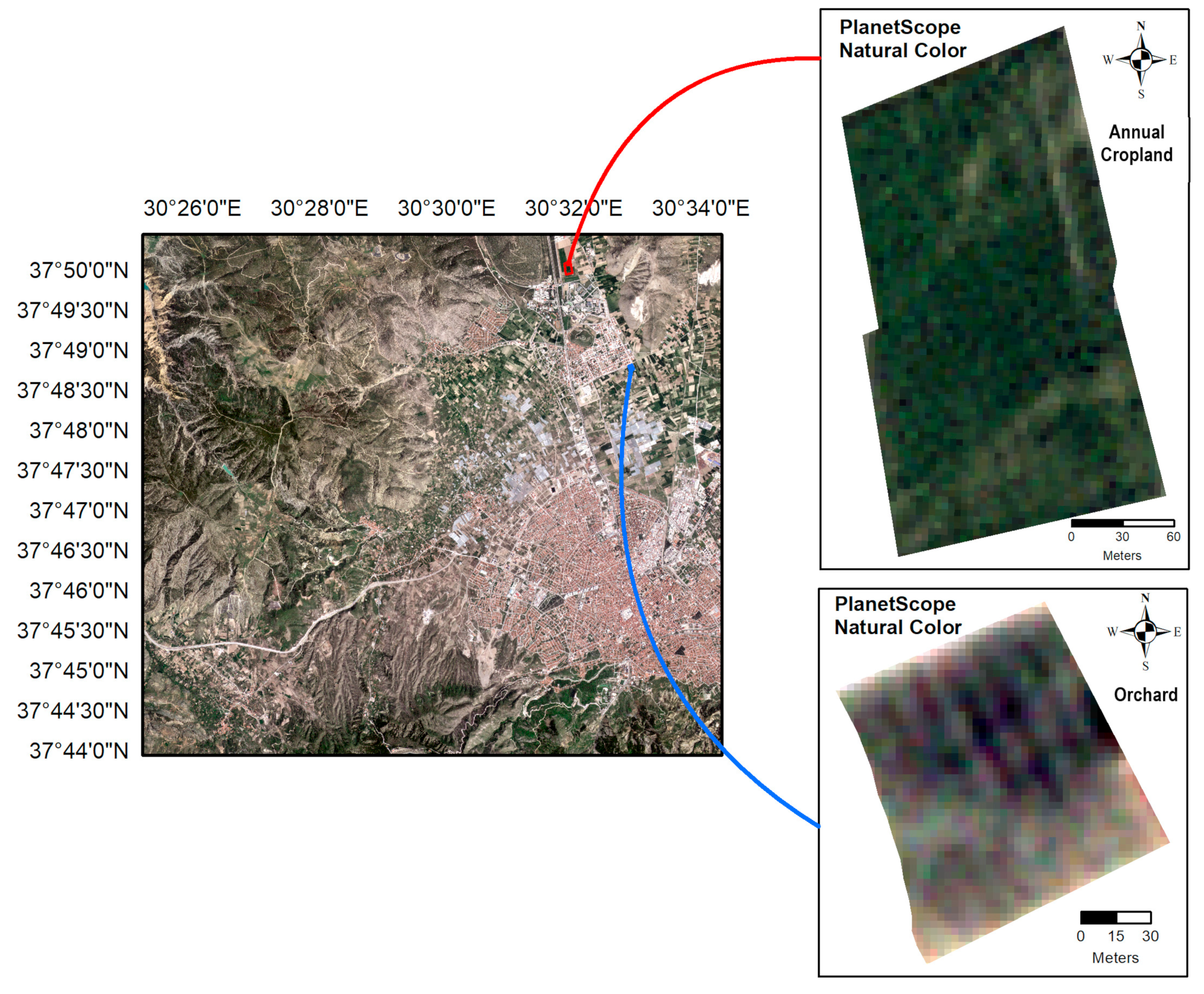
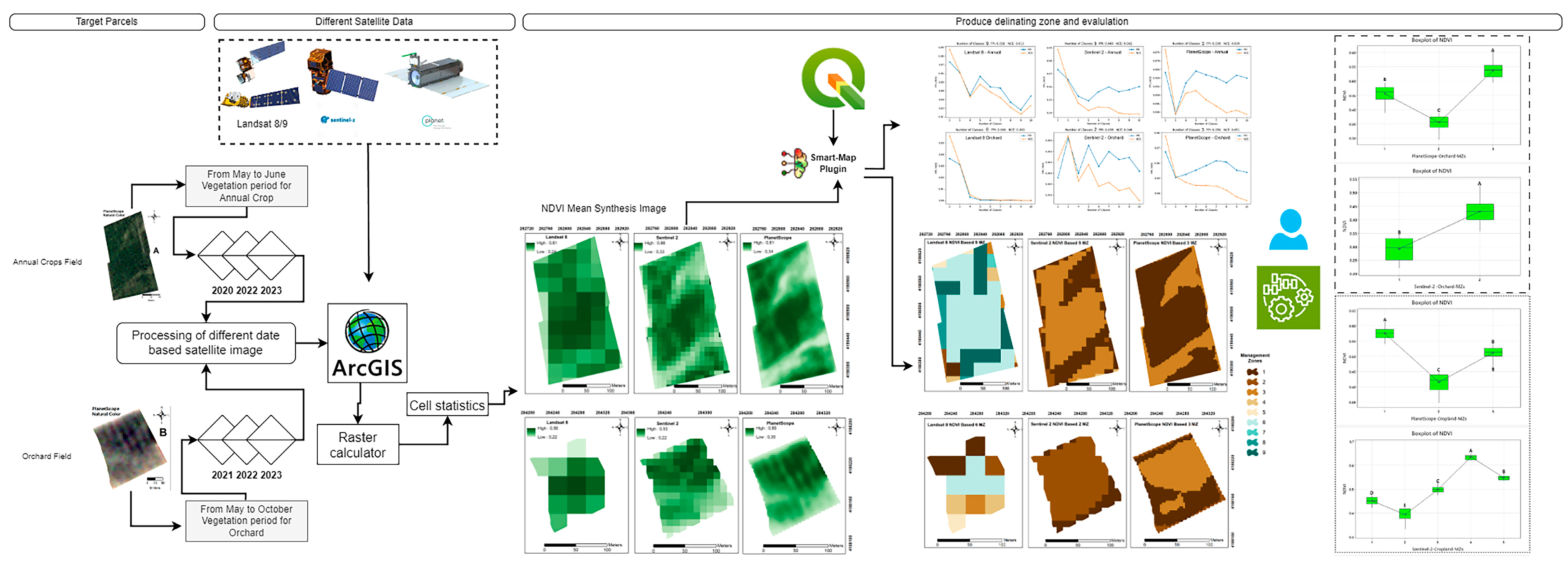


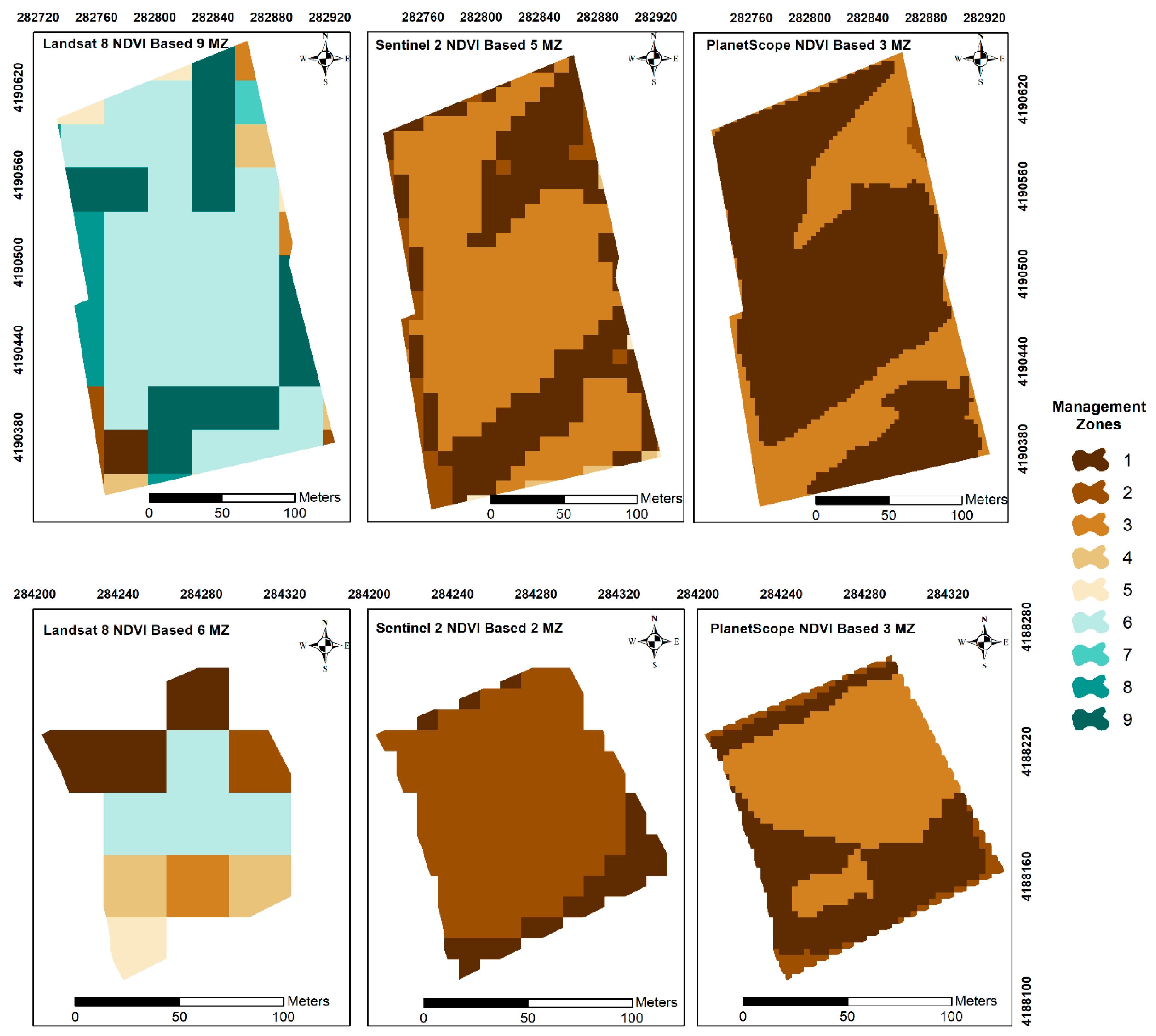

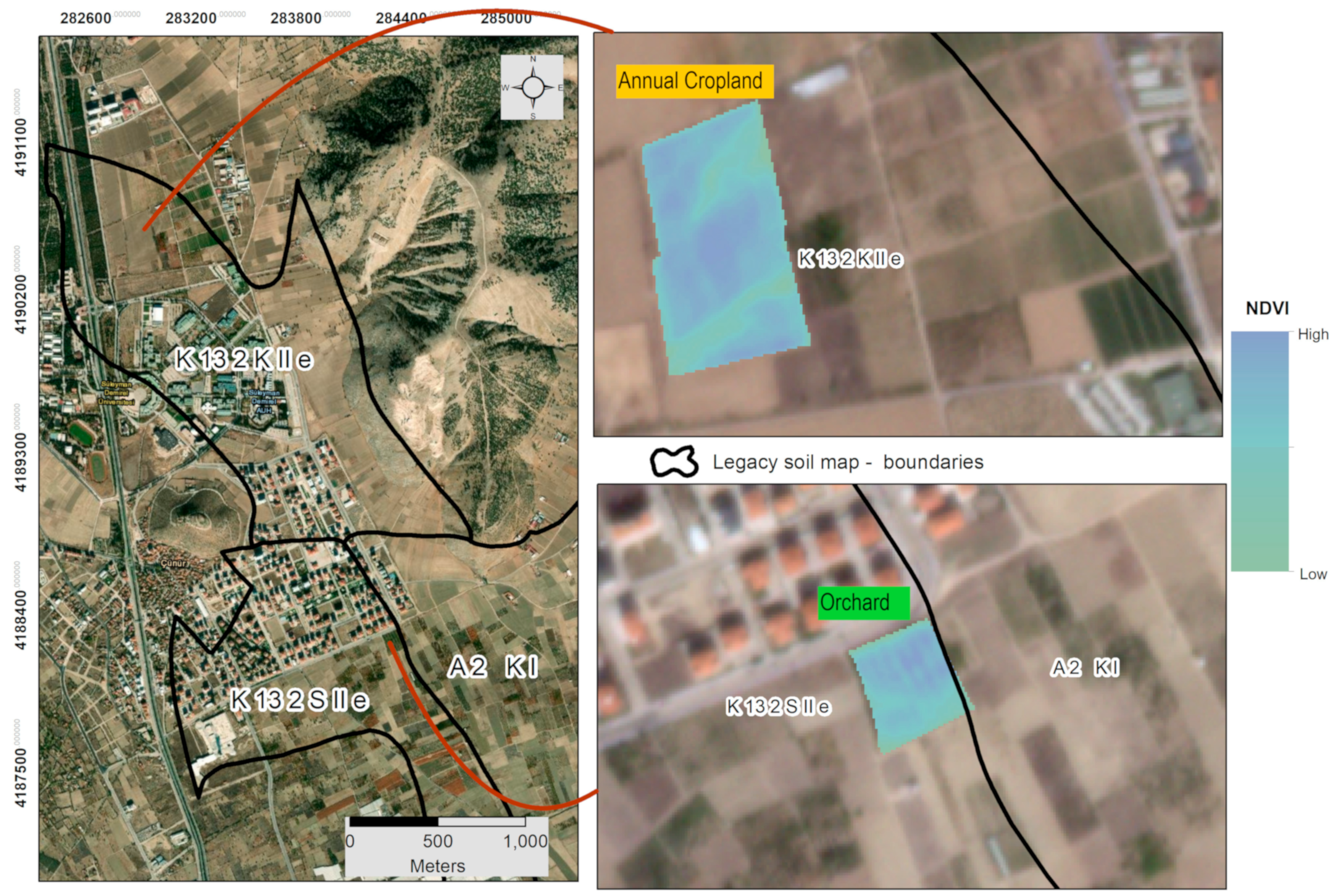
| Satellite | Annual Cropland | Orchard | Relevant Band Properties |
|---|---|---|---|
| Month—Year—Image Number | Month—Year—Image Number | ||
| Landsat 8 | April—2020—1 May—2020—1 June—2020—0 | May—2021—1/June—2021—1 July—2021—1/August—2021—1 September—2021—2/October—2021—1 | Spatial resolution: 30 m Temporal resolution: 16 days Red Band Spectral resolution: 0.636–0.673 μm NIR Band Spectral resolution: 0.851–0.879 μm Radiometric resolution: 12 bits [30] |
| April—2022—0 May—2022—1 June—2022—1 | May—2022—0/June—2022—1 July—2022—2/August—2022—1 September—2022—2/October—2022—1 | ||
| April—2023—0 May—2023—1 June—2023—0 | May—2023—0/June—2023—1 July—2023—2/August—2023—2 September—2023—1/October—2023—0 | ||
| Sentinel-2 | April—2020—2 May—2020—2 June—2020—1 | May—2021—6/June—2021—7 July—2021—10/August—2021—11 September—2021—9/October—2021—5 | Spatial resolution: 10 m Temporal resolution: 5 days Red Band Spectral resolution: 0.665 μm (Central wavelength) NIR Band Spectral resolution: 0.842 μm (Central wavelength) Radiometric resolution: 12 bits [34] |
| April—2022—7 May—2022—7 June—2022—2 | May—2022—7/June—2022—4 July—2022—11/August—2022—11 September—2022—10/October—2022—4 | ||
| April—2023—3 May—2023—3 June—2023—0 | May—2023—1/June—2023—5 July—2023—11/August—2023—12 September—2023—8/October—2023—5 | ||
| PlanetScope | April—2020—5 May—2020—5 June—2020—1 | May—2021—4/June—2021—3 July—2021—3/August—2021—6 September—2021—4/October—2021—4 | Dove-R—PS2.SD and SuperDove—PSB.SD Spatial resolution: 3.7 m Temporal resolution: 1 day Red Band Spectral resolution: 0.650–0.682 μm NIR Band Spectral resolution: 0.845–0.888 μm Radiometric resolution: 12 bits [29] |
| April—2022—0 May—2022—7 June—2022—3 | May—2022—3/June—2022—3 July—2022—3/August—2022—3 September—2022–3/October—2022—3 | ||
| April—2023—2 May—2023—4 June—2023—3 | May—2023—2/June—2023—8 July—2023—9/August—2023—9 September—2023—9/October—2023—0 |
| Sensor | Cultivation Type | Cluster Number | FPI | NCE | Pixel Count | Pixels per Cluster (Approximate) |
|---|---|---|---|---|---|---|
| Landsat 8 | Annual Cropland | 9 | 0.018 | 0.013 | 63 | 7 |
| Orchard | 6 | 0.000 | 0.000 | 12 | 2 | |
| Sentinel-2 | Annual Cropland | 5 | 0.049 | 0.042 | 456 | 91 |
| Orchard | 2 | 0.038 | 0.046 | 126 | 63 | |
| PlanetScope | Annual Cropland | 3 | 0.039 | 0.039 | 4650 | 1550 |
| Orchard | 3 | 0.050 | 0.051 | 1404 | 468 |
| Sentinel-2 Orchard MZs—one-way ANOVA | |||||||||
| Grouping * | MZs | N | Mean | StDev | 95% CI | DF | R-sq(adj) | F-Value | p-Value |
| B | 1 | 22 | 0.29 | 0.04 | (0.276; 0.308) | 1 | 64.73% | 230.46 | 0.000 |
| A | 2 | 104 | 0.43 | 0.03 | (0.422; 0.437) | ||||
| PlanetScope Orchard MZs—Welch’s ANOVA | |||||||||
| Grouping | MZs | N | Mean | StDev | 95% CI | DF | R-sq(adj) | F | p |
| B | 1 | 566 | 0.46 | 0.03 | (0.453; 0.458) | 2 | 80.62% | 3328.29 | 0.000 |
| C | 2 | 94 | 0.36 | 0.02 | (0.351; 0.360) | ||||
| A | 3 | 744 | 0.54 | 0.03 | (0.535; 0.538) | ||||
| Sentinel-2 Cropland MZs—Welch’s ANOVA | |||||||||
| Grouping | MZs | N | Mean | StDev | 95% CI | DF | R-sq(adj) | F | p |
| D | 1 | 155 | 0.45 | 0.01 | (0.448; 0.453) | 4 | 88.02% | 667.50 | 0.000 |
| E | 2 | 37 | 0.39 | 0.02 | (0.385; 0.401) | ||||
| C | 3 | 249 | 0.50 | 0.01 | (0.496; 0.499) | ||||
| A | 4 | 8 | 0.63 | 0.01 | (0.623; 0.645) | ||||
| B | 5 | 7 | 0.55 | 0.01 | (0.537; 0.558) | ||||
| PlanetScope Cropland MZs—Welch’s ANOVA | |||||||||
| Grouping | MZs | N | Mean | StDev | 95% CI | DF | R-sq(adj) | F | p |
| A | 1 | 3209 | 0.57 | 0.01 | (0.574; 0.575) | 2 | 74.82% | 5996.17 | 0.000 |
| C | 2 | 35 | 0.42 | 0.03 | (0.406; 0.425) | ||||
| B | 3 | 1406 | 0.51 | 0.02 | (0.510; 0.512) | ||||
Disclaimer/Publisher’s Note: The statements, opinions and data contained in all publications are solely those of the individual author(s) and contributor(s) and not of MDPI and/or the editor(s). MDPI and/or the editor(s) disclaim responsibility for any injury to people or property resulting from any ideas, methods, instructions or products referred to in the content. |
© 2025 by the authors. Licensee MDPI, Basel, Switzerland. This article is an open access article distributed under the terms and conditions of the Creative Commons Attribution (CC BY) license (https://creativecommons.org/licenses/by/4.0/).
Share and Cite
Kaya, F.; Ferhatoglu, C.; Başayiğit, L. Multi-Temporal Normalized Difference Vegetation Index Based on High Spatial Resolution Satellite Images Reveals Insight-Driven Edaphic Management Zones. AgriEngineering 2025, 7, 92. https://doi.org/10.3390/agriengineering7040092
Kaya F, Ferhatoglu C, Başayiğit L. Multi-Temporal Normalized Difference Vegetation Index Based on High Spatial Resolution Satellite Images Reveals Insight-Driven Edaphic Management Zones. AgriEngineering. 2025; 7(4):92. https://doi.org/10.3390/agriengineering7040092
Chicago/Turabian StyleKaya, Fuat, Caner Ferhatoglu, and Levent Başayiğit. 2025. "Multi-Temporal Normalized Difference Vegetation Index Based on High Spatial Resolution Satellite Images Reveals Insight-Driven Edaphic Management Zones" AgriEngineering 7, no. 4: 92. https://doi.org/10.3390/agriengineering7040092
APA StyleKaya, F., Ferhatoglu, C., & Başayiğit, L. (2025). Multi-Temporal Normalized Difference Vegetation Index Based on High Spatial Resolution Satellite Images Reveals Insight-Driven Edaphic Management Zones. AgriEngineering, 7(4), 92. https://doi.org/10.3390/agriengineering7040092









